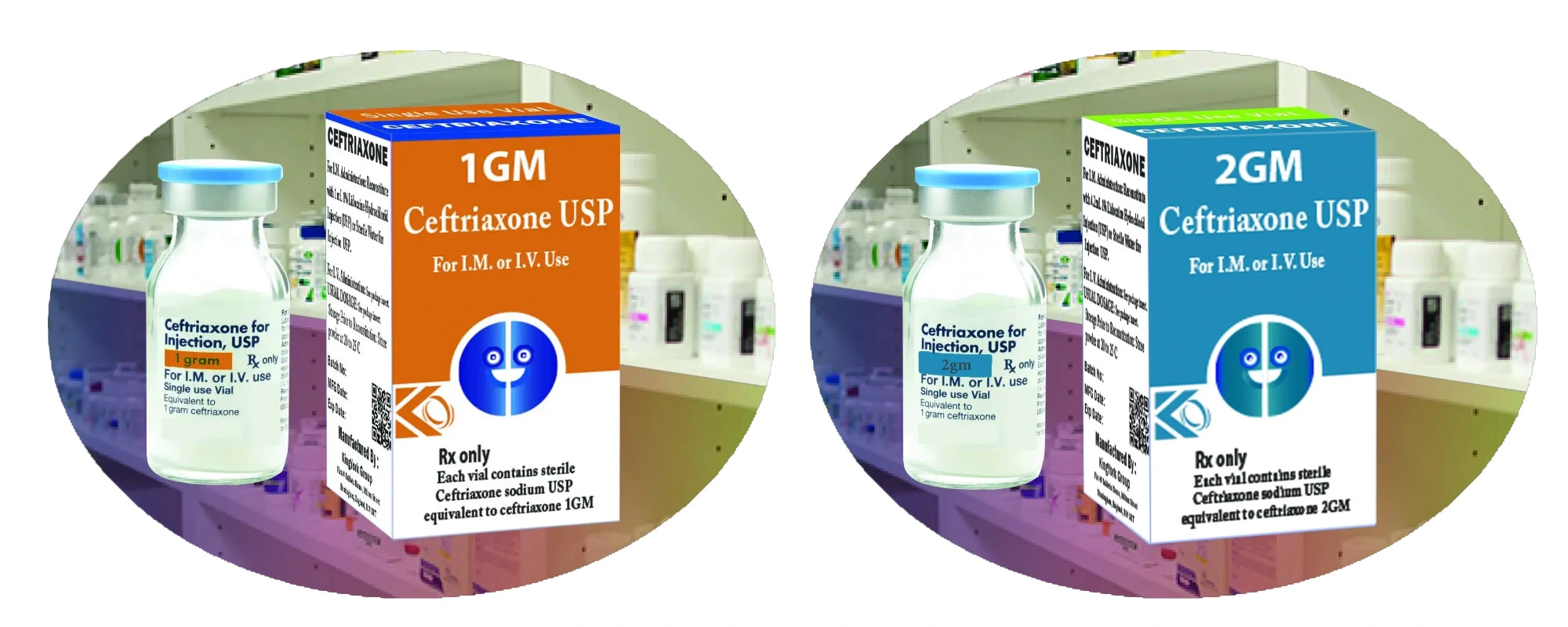Ceftriaxone Key Takeaways
• Ceftriaxone is a third-generation cephalosporin antibiotic used to treat bacterial infections. It works by stopping the growth of bacteria.
• Ceftriaxone vials are available in different strengths, typically 250 mg, 500 mg, 1 g, and 2 g. The dosage is based on the type and severity of infection, age, weight, and kidney function.
• Ceftriaxone vials must be reconstituted with sterile water or lidocaine and given by intravenous or intramuscular injection over at least 2-4 minutes. The reconstituted solution should be used within 24 hours if refrigerated.
• Ceftriaxone is effective at treating various bacterial infections including pneumonia, bone and joint infections, intra-abdominal infections, sepsis, gonorrhea, pelvic inflammatory disease, and meningitis.
• Potential side effects of ceftriaxone include diarrhea, nausea, vomiting, infections, fever, headache, and pain or inflammation at the injection site. Severe allergic reactions are possible.
• Ceftriaxone can interact with other medications like blood thinners and calcium-containing products. It's important to tell the provider about all medications and supplements being taken.
• Ceftriaxone vials should be stored sealed in the refrigerator at 36-46°F (2-8°C). After reconstitution, the vials should be used promptly or refrigerated for no more than 24 hours. Proper handling and disposal of needles is important.
• When administered correctly, ceftriaxone vials can be a safe and effective antibiotic treatment. Patients should follow up with the provider to ensure the infection has resolved.
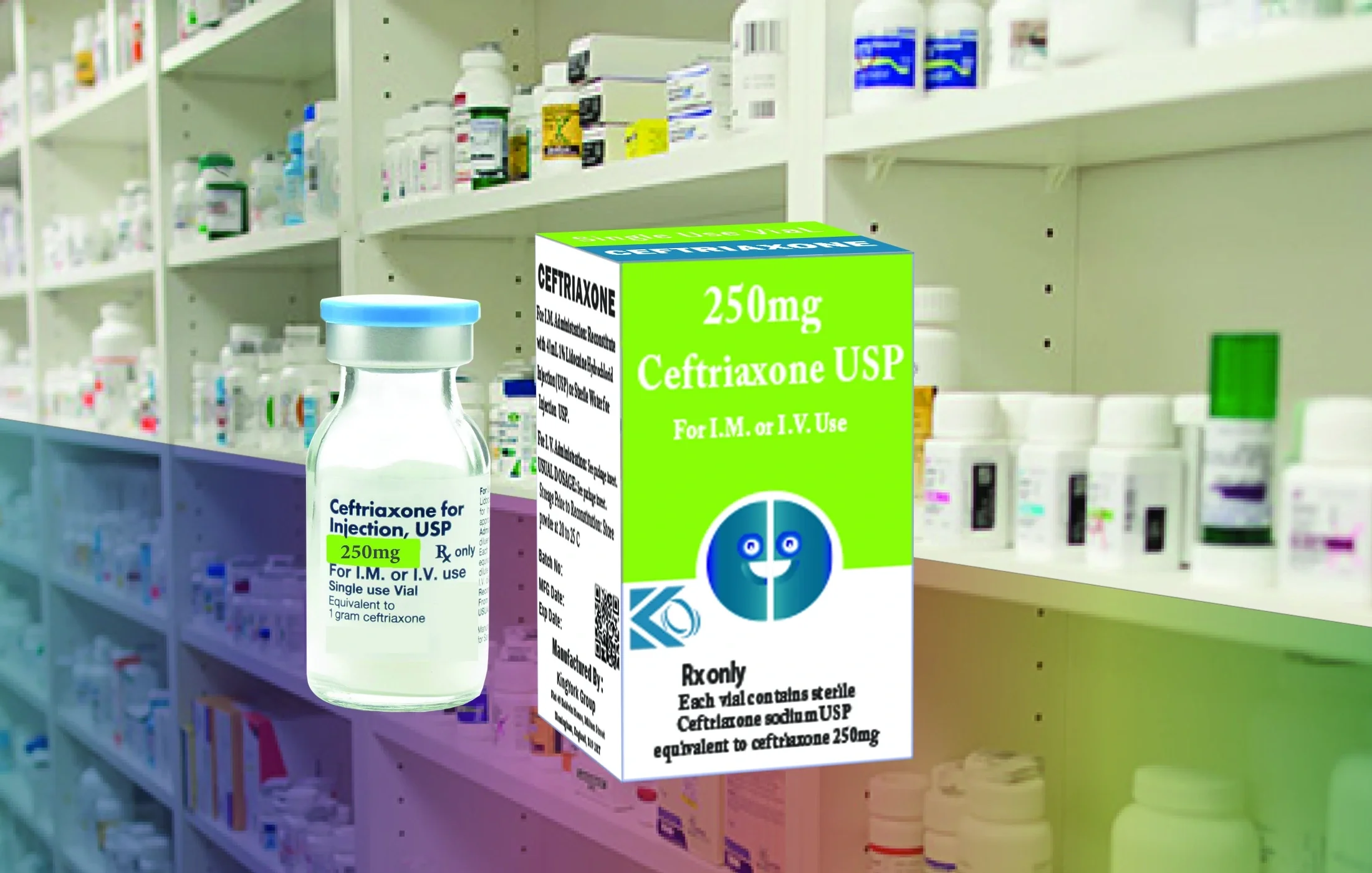
Ceftriaxone vials 250mg
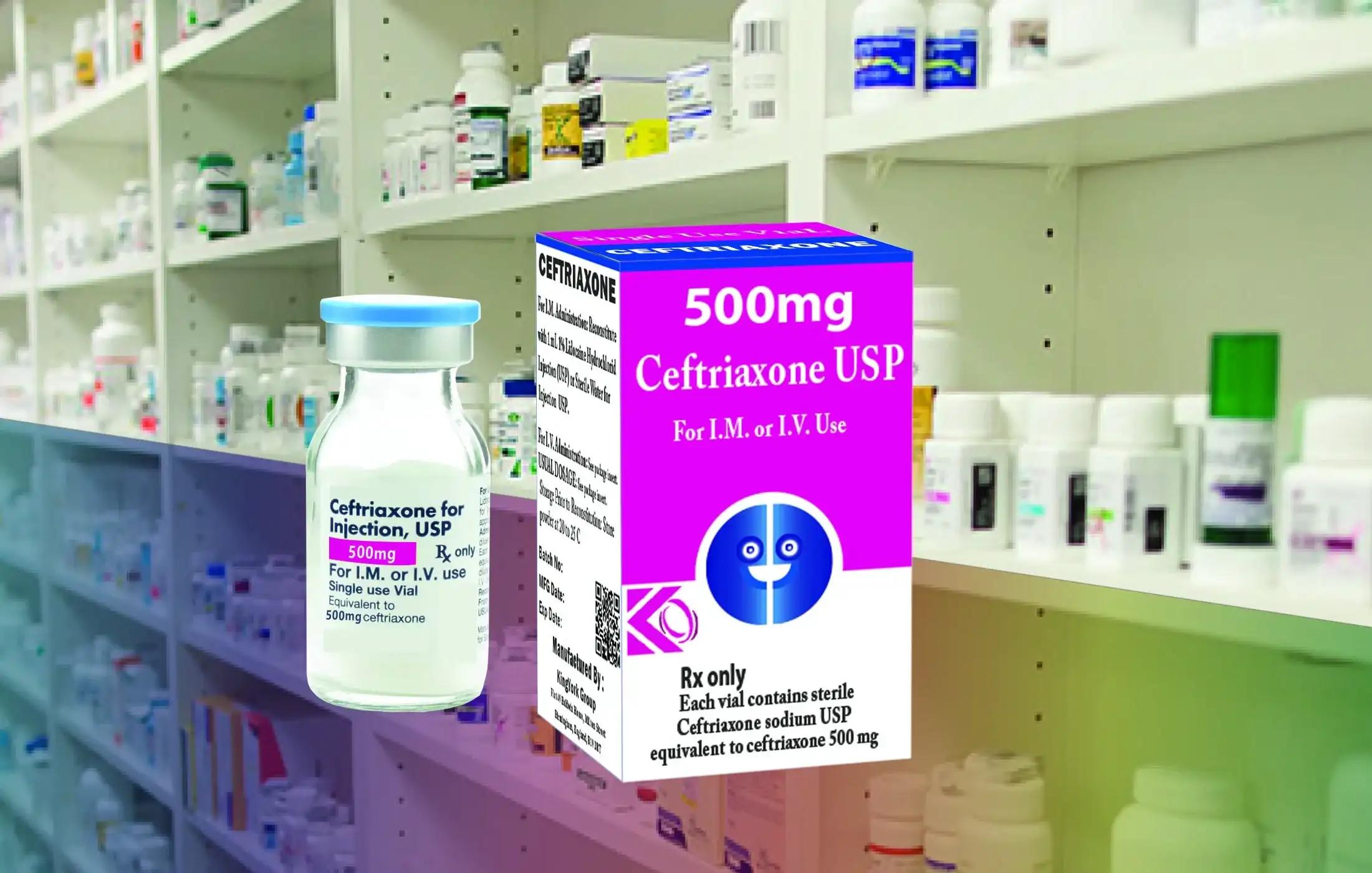
Ceftriaxone vials 500mg
What are Uses of Ceftriaxone?
Ceftriaxone is a versatile antibiotic that can treat a wide variety of bacterial infections. Some of the most common types of infections treated with ceftriaxone include:
• Respiratory infections: Ceftriaxone is often used to treat respiratory tract infections like bronchitis, pneumonia, and sinusitis. It works against common bacteria that cause these illnesses including Streptococcus pneumoniae, Haemophilus influenzae, and Moraxella catarrhalis.
• Urinary tract infections (UTIs): Ceftriaxone is effective at treating complicated UTIs caused by organisms like Escherichia coli, Klebsiella pneumoniae, Proteus mirabilis, and Enterobacter. It can be used for both upper and lower UTIs.
• Skin infections: Skin and soft tissue infections caused by Staphylococcus aureus and Streptococcus pyogenes respond well to ceftriaxone. It covers MRSA infections too. Common infections treated include cellulitis, abscesses, and infected wounds.
• Sexually transmitted infections (STIs): Ceftriaxone is recommended as part of the treatment regimen for gonorrhea to slow antibiotic resistance. It treats genital, rectal, throat, and disseminated gonorrhea infections.
• Lyme disease: For neurologic, joint, or cardiac forms of Lyme disease, ceftriaxone is used. It can also treat early-stage Lyme when doxycycline cannot be used.
• Bone, joint, blood infections: Ceftriaxone treats septic arthritis, osteomyelitis, septicemia, and endocarditis. It fights organisms like Staphylococcus aureus, Streptococcus agalactiae, and various Enterobacteriaceae.
• Meningitis: Ceftriaxone is a first-line treatment for acute bacterial meningitis caused by common bacteria like S. pneumoniae, N. meningitidis, and H. influenzae.
• Intra-abdominal infections: Ceftriaxone is used alongside metronidazole for complicated diverticulitis, appendicitis, peritonitis, cholangitis, and other infections in the digestive tract.
• Surgical prophylaxis: Ceftriaxone is often given before surgeries as a preventative measure, especially orthopedic, cardiovascular, and gastrointestinal procedures.
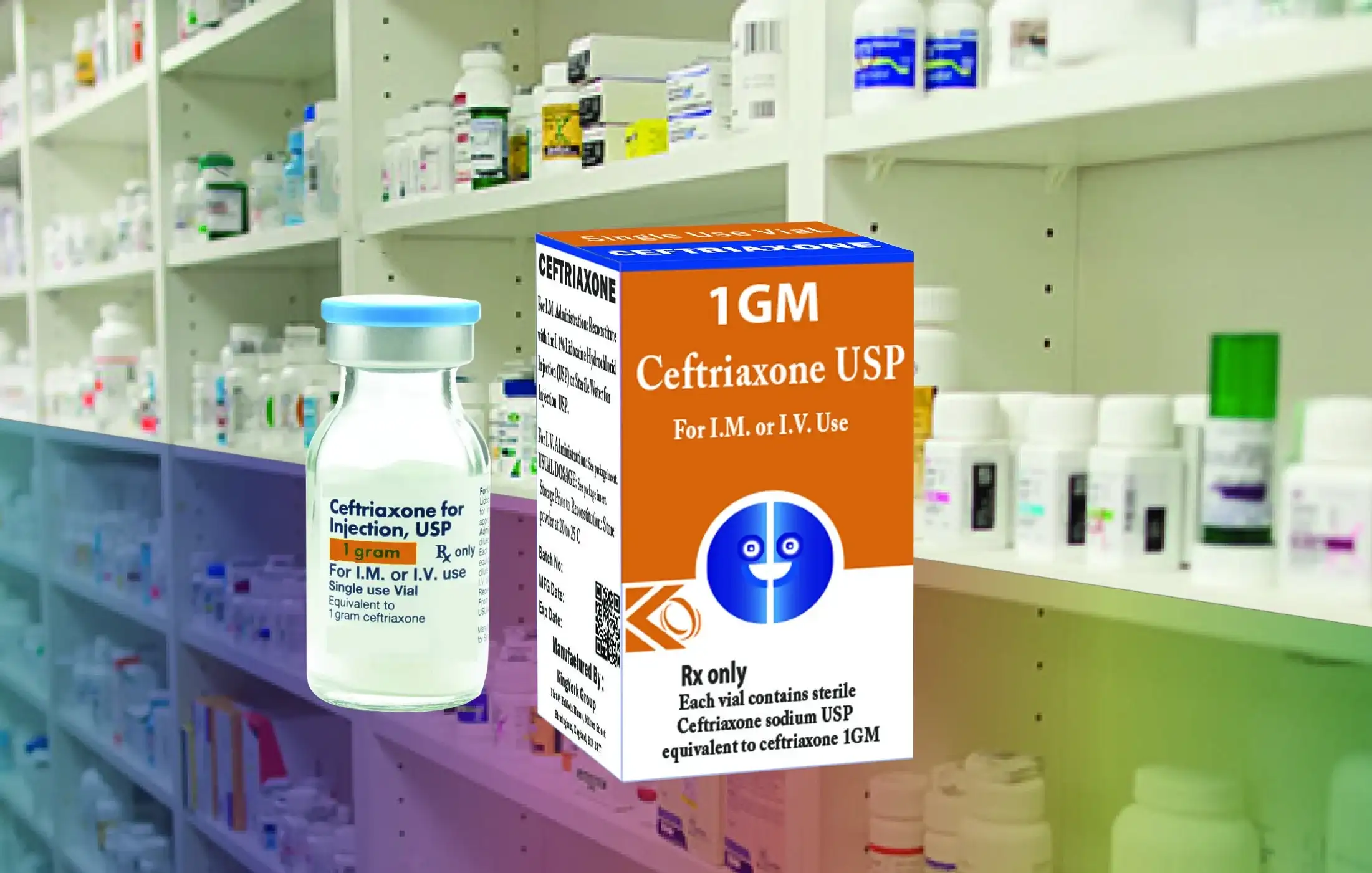
Ceftriaxone vials 1gm
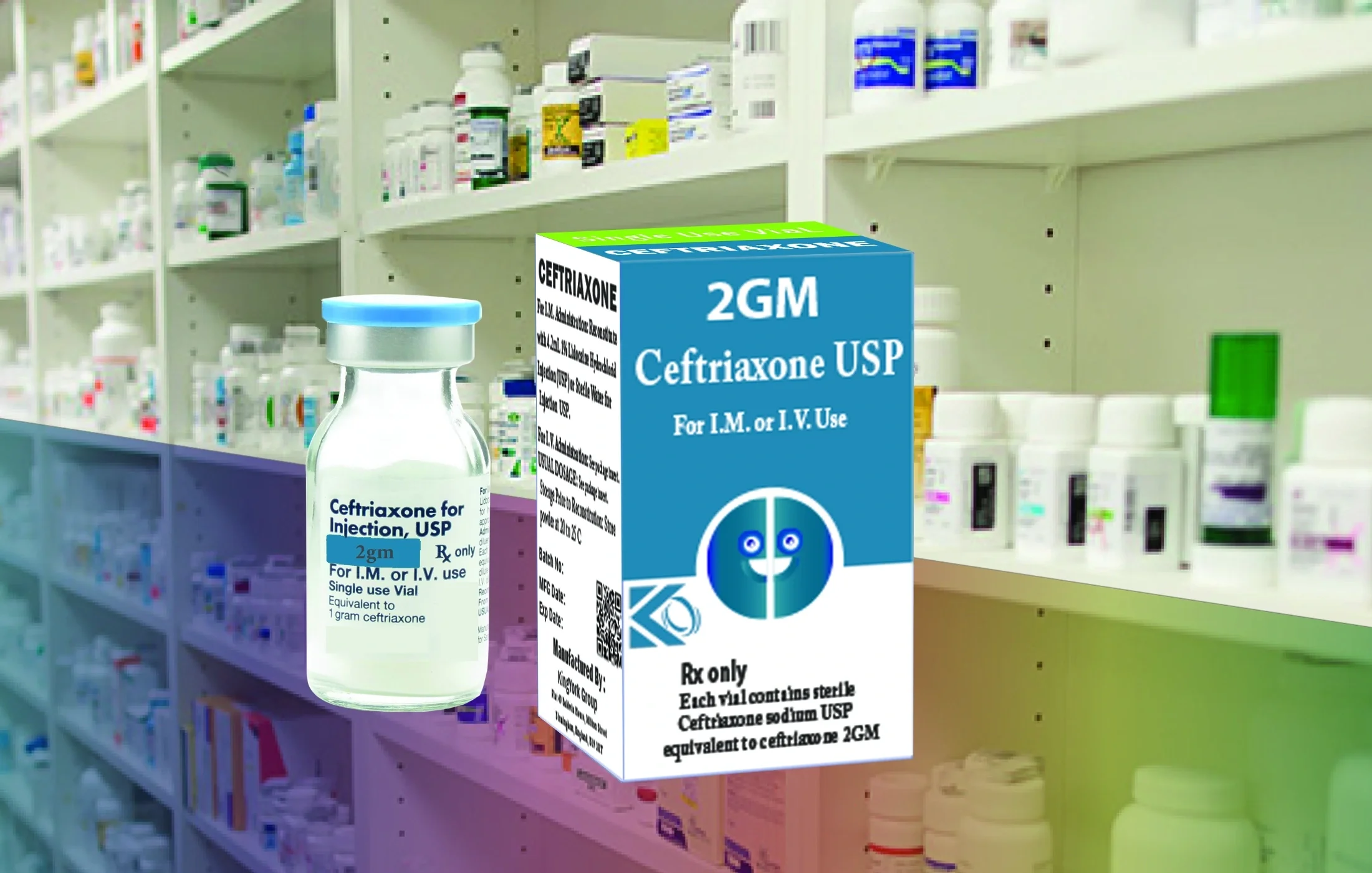
Ceftriaxone vials 2gm
Forms and Dosage
Ceftriaxone is available in several forms for administration via injection:
• Vials containing 250 mg, 500 mg, 1 g, or 2 g of ceftriaxone as a sterile powder that must be reconstituted with sterile water or another appropriate diluent before use.
• Pre-mixed solutions containing 250 mg/50 mL, 500 mg/50 mL, or 1 g/50 mL of ceftriaxone in 0.9% sodium chloride, 5% dextrose, or lacterated Ringer's solution. These are ready to inject without reconstitution
The recommended dosage of ceftriaxone depends on the type and severity of infection being treated. Some general dosage guidelines include:
• Adults: 1-2 grams administered once daily, either as a single dose or divided doses. Severe infections may require higher doses up to 4 grams daily.
• Children: 20-80 mg/kg per day depending on age, up to a maximum of 2 grams daily. This is typically divided into one or two doses.
• Newborns: 20-50 mg/kg body weight as a single daily dose for those aged 0-7 days, and 20-80 mg/kg for those aged 8-28 days.
Renal impairment may require dose adjustments. Always follow the dosage instructions provided by your healthcare provider.
Administration of Ceftriaxone Vials
Reconstitution
Ceftriaxone vials must be reconstituted before administration. Here are the steps:
• Inspect the vial for any damage or particles. If present, use a new vial.
• Ceftriaxone is sensitive to light, so reconstitute immediately before use.
• Use aseptic technique throughout. Clean the vial stopper with antiseptic and allow to dry.
• For intramuscular injection, reconstitute ceftriaxone powder with 1% lidocaine HCl solution.
• For intravenous injection, reconstitute with sterile water for injection. Other diluents should not be used.
• Add the required amount of diluent. Agitate to dissolve.
• Inspect the reconstituted solution. It should be clear and free of particulate matter. If not, discard and start again with a new vial.
Intramuscular Injection
• Use a 21-23 gauge, 1-1.5 inch needle for gluteal IM injection in adults. Choose the ventrogluteal site.
• For infants and children under 30 kg, use a 21-25 gauge, 1-1.5 inch needle into the mid-lateral thigh.
• Ceftriaxone for IM injection should be injected deep into muscle mass.
• The maximum volume per injection site is 3 mL for adults and children.
• After inserting the needle, aspirate to check for blood. If present, withdraw and use a new site.
• Inject the dose slowly.
• Remove the needle and apply pressure to the site for 1-2 minutes.
Intravenous Injection
• For direct IV injection, administer over 5 minutes into a large vein. Monitor closely.
• For IV infusion, dilute in compatible solutions like normal saline or dextrose.
• Infuse over 30-60 minutes. The concentration should not exceed 40 mg/mL.
• Flush existing IV lines before and after infusing ceftriaxone to avoid precipitation.
• Do not co-administer ceftriaxone and calcium solutions through the same line.

Ceftriaxone vials 250mg

Ceftriaxone vials 500mg
Storage and Handling
Ceftriaxone for injection is supplied as a sterile powder in vials. It should be stored at 20°C to 25°C (68°F to 77°F) and protected from light. Ceftriaxone sodium has a shelf life of 24 months from the date of manufacture when stored properly.
After reconstitution, ceftriaxone solutions should be used promptly. Any unused portion should be discarded. However, maximum storage times for reconstituted ceftriaxone solutions are:
• 24 hours at room temperature
• 72 hours under refrigeration (2°C to 8°C or 36°F to 46°F)
• 10 days in frozen state (-20°C or -4°F)
Ceftriaxone solutions exhibit maximum stability in neutral to mildly alkaline pH. It is unstable in acidic environments, so should not be reconstituted or mixed with diluents having a pH less than 6.
Proper aseptic technique should be used during reconstitution and administration to maintain sterility. The vial stopper should be cleaned with an antiseptic solution before entering with a needle. After reconstitution, the solution should be swirled gently, not shaken vigorously, to avoid foaming.
Care should be taken to avoid accidental contact of solutions containing ceftriaxone with eyes and skin. Staff should wear protective clothing and eye protection when handling ceftriaxone. Spills should be cleaned promptly with copious amounts of water.

Ceftriaxone vials 1gm

Ceftriaxone vials 2gm
Effectiveness
Ceftriaxone is a third-generation cephalosporin antibiotic that has been shown to be effective against a wide range of Gram-positive and Gram-negative bacteria. Some key points about the efficacy of ceftriaxone:
• For common bacterial infections like pneumonia, sinusitis, and skin infections, ceftriaxone has cure rates of over 90% in most cases. It is considered a first-line antibiotic for these conditions.
• Ceftriaxone maintains high efficacy rates for serious infections like meningitis (over 85% cure rate) and severe sepsis (80-95% cure rate when used along with other antibiotics).
• It has shown good activity against both community-acquired and hospital-acquired strains of common bacteria like Streptococcus pneumoniae, Staphylococcus aureus, Escherichia coli, and Klebsiella pneumoniae.
• However, resistance rates have been increasing worldwide, especially for E. coli and K. pneumoniae. Up to 30% of these bacteria may be resistant to ceftriaxone depending on geographic region.
• Ceftriaxone remains mostly active against Pseudomonas aeruginosa, with resistance rates less than 20% on average. It has poor activity against anaerobic bacteria and enterococci.
• Due to rising resistance, ceftriaxone should not be used empirically alone for serious hospital-acquired infections. It needs to be combined with other antibiotics based on bacterial susceptibility testing.
So in summary, ceftriaxone maintains high efficacy for common community-acquired infections, but resistance is a concern, especially in healthcare settings. It is critical to monitor local susceptibility patterns to guide appropriate ceftriaxone use.

Ceftriaxone vials 250mg

Ceftriaxone vials 500mg
Ceftriaxone vials Side Effects
Ceftriaxone is generally well tolerated, but some side effects can occur. The most common minor side effects include pain, redness, swelling, or irritation at the injection site; diarrhea; headache; and unusual tiredness or weakness. These side effects are usually mild and go away on their own.
More serious side effects are less common but can sometimes occur. Seek medical attention if you experience any of the following while taking ceftriaxone:
• Rash, hives, or itching
• Wheezing or difficulty breathing
• Swelling of the face, throat, tongue, lips, or eyes
• Fever, chills, or sore throat
• Unusual bleeding or bruising
• Jaundice - yellowing of the skin or eyes
Ceftriaxone should not be used by those with a known allergy to ceftriaxone or other cephalosporin antibiotics. It is also contraindicated in premature infants and neonates due to the risk of bilirubin encephalopathy. Use caution when administering ceftriaxone to patients with a history of gastrointestinal disease, especially colitis, as diarrhea can worsen.
As with any medication, discuss all potential side effects with your doctor before starting treatment with ceftriaxone. Promptly report any concerning symptoms so they can determine if adjustments need to be made.
Interactions
Ceftriaxone can interact with other medications. Some of the most notable drug interactions include:
• Calcium-containing products - Ceftriaxone can form insoluble precipitates with calcium. Do not administer ceftriaxone and calcium-containing IV solutions together. Allow at least 48 hours between administering ceftriaxone and calcium-containing products.
• Oral contraceptives - Ceftriaxone may reduce the effectiveness of birth control pills. Use alternative birth control methods.
• Diuretics like furosemide - Ceftriaxone can increase the risk of kidney toxicity. If given together, monitor kidney function.
• Probenecid - Can increase blood levels of ceftriaxone and increase risk of toxicity. Avoid this combination when possible.
• Aminoglycosides like gentamicin - Concurrent use can increase risk of kidney toxicity. If used together, monitor kidney function closely.
Some foods and beverages can also interact with ceftriaxone:
• Alcohol - Ceftriaxone should not be mixed with alcohol. Alcohol can worsen side effects like dizziness. Avoid alcohol during treatment.
• Dairy products - Dairy may reduce the absorption of ceftriaxone. Avoid dairy for 2 hours before and after taking ceftriaxone.
Let your doctor know if you are taking any other medications, supplements, or herbal products to prevent potential interactions with ceftriaxone. Monitoring may be required.

Ceftriaxone vials 1gm

Ceftriaxone vials 2gm
Warnings
Ceftriaxone injection requires special precautions due its potential risks. Here are some important warnings to be aware of:
• Risk of gallbladder complications: Ceftriaxone can cause precipitates to form in the gallbladder, which may lead to symptoms like right upper quadrant abdominal pain, nausea, or vomiting. This risk appears higher in pediatric patients. Ceftriaxone use for more than 10 days in patients of any age increases the risk.
• Risk of pancreatitis: There have been postmarketing reports of acute pancreatitis, which may be fatal, in patients receiving ceftriaxone. Most cases occurred within the first week of treatment. If pancreatitis is suspected, ceftriaxone should be discontinued.
• Hypersensitivity reactions: Severe, and sometimes fatal, allergic reactions have occurred in some patients receiving β-lactam antibiotics like ceftriaxone. Before therapy, inquire about previous hypersensitivity reactions to penicillins, cephalosporins, or other allergens. Discontinue immediately if an allergic reaction occurs.
• Interference with blood glucose tests: Ceftriaxone can falsely lower blood glucose readings with some glucometer and test strip systems. Always use the same meter and strips to test blood glucose levels. Notify the laboratory if the patient receives ceftriaxone.
• Hematologic effects: Ceftriaxone can cause hematologic adverse reactions like granulocytopenia, hemolytic anemia, or thrombocytopenia. Perform blood counts if these effects are suspected.
• Overgrowth of non-susceptible organisms: Prolonged ceftriaxone use may result in overgrowth of non-susceptible organisms like Enterococcus or Candida. Carefully monitor patients if treatment exceeds 10 days.
• Neurotoxicity: Cephalosporins can cause encephalopathy or seizures, especially in patients with impaired renal function. Use ceftriaxone cautiously in these patients.
• Contraindications: Do not administer ceftriaxone in infants younger than 28 days if they require treatment for suspected sepsis, have hyperbilirubinemia, or receive calcium solutions. The drug is also contraindicated in neonates for routine antimicrobial prophylaxis to prevent perinatal transmission of Group B streptococci.
Inform patients of these warnings and monitor for any signs of adverse reactions. Promptly evaluate and address any concerns that develop during ceftriaxone treatment.
Registration:
WE CAN DO THE REGISTRATION DOCUMENTS AND CERTIFICATES IF IT IS NEEDED.
Product Specifications:
Ceftriaxone vials 250mg
SKU“stock keeping unit”:2024.cef5001
gtin14:20231111002004
Price:0.60 - 0.79$.
Price Currency: USD
Price Valid Until:"2026-11-20

Ceftriaxone vials 250mg

Ceftriaxone vials 500mg
Ceftriaxone vials 500mg
Volume:1ml.
Dosage:1g.
Active Ingredients:ceftriaxone as the sodium salt.
Specifications:BP;USP.
Packaging:vials,1;10.
Registration:
We will prepare registration documents and certificates as necessary.
Product List - Liquid Injections
| Product Name |
Strength |
| Vitamin B1 injection |
100mg: 2ml |
| Vitamin B6 Injection |
0.1g: 2ml |
| Vitamin B12 injection |
0.5mg:1ml |
| VIT-B Complex injection |
2ml |
| Tri B-inj B1-100mg+B2-100mg+B12-1000mcg |
3ml |
| Vitamin C injection |
0.5g:2ml |
| VITAMIN K1 injection |
10mg:1ml |
| Dexamethasone Na phosphate injection |
4mg: 1ml |
| Dexamethasone Na phosphate injection |
8mg: 2ml |
| Diclofenac Sodium Injection |
75mg:3ml |
| Metoclopramide hydrochloride injection |
10mg:2ml |
| Metoclopramide hydrochloride injection |
5mg:1ml |
| Iron Sucrose IV Injection |
100mg:5ml |
| Iron Dextran Injection |
100mg:2ml |
| Promethazine Hydrochloride Injection |
50mg:2ml |
| Gentamycin sulfate injection |
40mg:2ml |
| Gentamycin sulfate injection |
80mg:2ml |
| Furosemide Injection |
20mg:2ml |
| Aminophylline Injection |
250mg:10ml |
| Paracetamol injection |
150mg:1ml |
| Paracetamol injection |
300mg:2ml |
| Paracetamol injection |
500mg:4ml |
| Paracetamol injection |
600mg:4ml |
| Paracetamol injection |
750mg:5ml |
| Diazepam injection |
5mg/1ml |
| Diazepam injection |
10mg:2ml |
| Diazepam injection |
5mg/1ml |
| Diazepam injection |
10mg:2ml |
| Oxytocin Injection |
5 iu/1ml |
| Oxytocin Injection |
10 iu / 1ml |
| Chlorphenamine Maleate Injection |
10mg:1ml |
| Hyoscine Butylbromide(Buscopan)Injection |
20mg:1ml |
| Lidocaine Hydrochloride injection |
10ml:0.2g |
| Methotrexate for Injection |
50mg:2ml |
| ENOXAPARIN SODIUM Prefilled syringe |
40MG/0.4ML |
| ENOXAPARIN SODIUM Prefilled syringe |
60MG/0.6ML |
| ENOXAPARIN SODIUM Prefilled syringe |
80MG/0.8ML |
| Adrenaline(Epinephrine HCL)Injection |
1mg:1ml |
| Testosterone 250mg:1ml |
250mg:1ml |
Product List - Vial Injections
| Product Name |
Strength |
| Omeprazol 40 mg IV VIAL |
10ml or 5ml |
| Pantoprazole Sodium for Injection |
40mg |
| Lansoprazole for Injection |
30 mg |
| Ceftriaxone 1gm/10ml IV VIAL |
+10ml water |
| Ceftriaxone 1gm/10ml VIAL |
+Lidocain 1% |
| Ceftriaxone IM/IV VIAL |
500mg/15 ml |
| Ampicillin Na VIAL |
0.5 g/Vial |
| Ampicillin Na VIAL |
1g/Vial |
| Cefotaxime Sodium for VIAL |
1g/Vial |
| Ceftazidime For I.M/I.V VIAL |
1g/Vial |
| Cefepime For I.M/I.V VIAL |
1g/Vial |
| Meropenem VIAL Injection |
1g/20ml/Vial |
| Procaine Penicillin(0.4mega/7ml) |
400.000 U/7ml |
| Procaine Penicillin(0.6mega/7ml) |
600.000 U/7ml |
| Procaine Penicillin(1.2mega/7ml) |
800.000 U/7ml |
| Procaine Penicillin (0.8mega/7ml) |
1200.000 U/7ml |
| Benzathine Penicillin for Injection |
1.2mega/7ml |
| Vancomycin Hcl injection 500mg |
500mg/Vial |
| Vancomycin Hcl injection 500mg |
1g/Vial |
| Heparin Sodium Injection |
5ml:5000 units |
| Heparin Sodium Injection |
5ml:25000 units |
| Amoxicillin Na and Clavulanate Potassium for Inj(augmentin) |
G Powder 1.2 |
| Amoxicillin Na and Clavulanate Potassium for Inj(augmentin) |
G Powder 0.6 |
| lyophilized Hydrocortisone Na Succinate |
3ml:0.1gm |
| aseptic lyophilized Hydrocortisone Na Succinate |
7m:0.1gm |
| Phenobarbital Sodium Injection |
1ml:0.1g |
| Piperacillin Sodium and Tazobactam Na for Inj |
4.5g |
Product List - IV INFUSION
| Product Name |
Strength |
| Paracetamol 1G IV infusion |
100ml glass bottle |
| Metronidazole 500mg IV infusion |
100ml glass bottle |
| Ciprofloxacine 200mg IV infusion |
20ml plastic bottle |
| 0.9% Na Chloride IV Inj |
500ml plastic bottle |
| 5% Glucose Injection |
250ml:12.5g,500ml:25g |
| 10% Glucose Injection |
250ml:12.5g,500ml:25g |
| Sodium Lactate Ringer`s Inj |
500ml Plastic Bottle |
| 5% Glu + 0.9% Na Chlorid inj 250ml: |
Glu 12.5g,NaCl 2.25g |
| 5% Glu + 0.9% Na Chlorid inj 500ml: |
Glu 25g,NaCl 4.5g |
| 10% Glu + 0.9% Na Chlorid inj 250ml: |
Glu 25g,NaCl 2.25g |
| 10% Glu + 0.9% Na Chlorid inj 500ml: |
Glu 50g,NaCl 4.5g |
| Mannitol injection |
250ml:50g P Bottle |
Product List - SYRUP
| Product Name |
Strength |
| Amoxicillin 125mg + Clavulanic Acid 31.5mg |
100 ml glass Bottle |
| Amoxicillin 250mg + Clavulanic Acid 62.5mg |
100 ml glass Bottle |
| Amoxicillin 400mg + Clavulanic Acid 75mg |
100 ml glass Bottle |
| Azithromycine 100mg |
15ml 1bottle/Box |
| Metronidazole 125mg |
100 ml glass Bottle |
| Metronidazole 250mg |
100 ml glass Bottle |
| Amoxicillin 125 mg |
100 ml glass Bottle |
| Amoxicillin 250 mg |
100 ml glass Bottle |
| Paracetamol syrup 250mg/5ml |
250mg/5ml syrup |
| Ibuprofen Dry Suspension 100mg/5ml |
100ml Suspension |
Product List - TABLETS
| Product Name |
Strength |
| Azithromycine 500mg Tab(3 tabs) |
3 tablets X 1 blister |
| Metronidazole 500mg Tab(14 tabs) |
7 tablets X 2 blisters |
| Ciprofloxacine 500mg TAB(10 tabs) |
10 tablets X 1 blister |
| Amoxicillin 250mg + Clavulanic Acid 125mg(14 tabs) |
7 tablets x 2 blister |
| Amoxicillin 500mg + Clavulanic Acid 125mg(14 tabs) |
7 tablets x 2 blister |
| Amoxicillin 875mg + Clavulanic Acid 125mg(14 tabs) |
7 tablets x 2 blister |
| Nitrofurantoin 100mg Tablets |
10 tablets X 1 blister |
| Aspirin Enteric-coated 500mg |
10 tablets X 1 blister |
| Paracetamol 500mg |
10 tablets X 1 blister |
| Ibuprofen 400mg |
10 tablets X 1 blister |
| Diclofenac Na 400mg |
10 tablets X 1 blister |
| Diclofenac 50mg + Paracetamol 500mg |
10 tablets X 1 blister |
| Folic acid 5mg Tab |
10 tablets X 1 blister |
| Ciprofloxacin Tablets |
10 tablets X 1 blister |
| Doxycycline 100mg Tab |
10 tablets X 1 blister |
| Meloxicam 15mg Tab |
10 tablets X 2 blisters |
| Fluconazole 150mg Tab |
10 tablets X 2 blisters |
| Simvastatin 40mg Tab |
10 tablets X 2 blisters |
| Prednisolone 5mg Tab |
10 tablets X 2 blisters |
| Spiramycin 750,000 unit Tab |
10 tablets X 2 blisters |
| Spiramycin 1,500,000 unit Tab |
10 tablets X 2 blisters |
Product List - CAPSULES
| Product Name |
Strength |
| Amoxicillin 500mg(16 Capsules) |
8 cap X 2 blisters |
| Ampicillin Capsules |
10 cap X 2 blisters |
| Cloxacillin Na Capsules |
10 cap X 2 blisters |
| Piroxicam Capsule |
10 cap X 2 blisters |
| Tetracyline 250 mg Capsule |
10 cap X 2 blisters |
| Oxytetracycline 250mg Capsule |
10 cap X 2 blisters |
| Spiramycin 375,000 unit Cap |
10 cap X 2 blisters |
| Indomethacin 25mg Capsule |
10 cap X 2 blisters |
Product List - Suppository
| Product Name |
Strength |
| Paracetamol 125mg suppository |
5 Supp x 2 blister |
| Paracetamol 250mg suppository |
5 Supp x 2 blister |
| Policresulen Vaginal 90mg Suppository |
4 Supp x 2 blister |
| Chlorhexidine Acetate 20mg Supp |
5 Supp x 2 blister |
| Miconazole Nitrate Vaginal 100mg Supp |
5 Supp x 2 blister |
| Clotrimazole Vaginal 150mg Supp |
5 Supp x 2 blister |
| Metronidazole Vaginal 500mg Supp |
5 Supp x 2 blister |
| Indomethacin 500mg Supp |
5 Supp x 2 blister |


